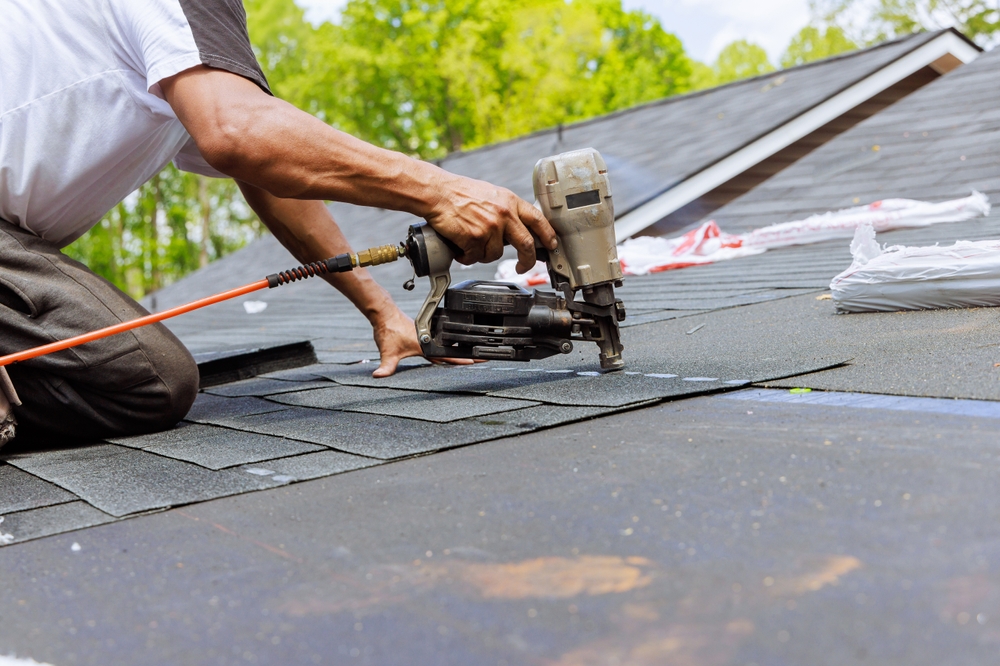
Homeowners often want to save money by tackling roof repairs themselves. It sounds simple—grab a ladder, some tools, and fix that leak or replace a shingle. But DIY roof repairs can be more dangerous than they seem. Every year, thousands of people end up in the emergency room after attempting to fix their own roofs. The risks are real: falls, electrical shocks, and even long-term injuries. Before you climb onto your roof, it’s important to understand which projects are likely to land you in the hospital.
1. Replacing Shingles on Steep Roofs
Replacing damaged shingles may look easy from the ground. But if your roof is steep or slick, one wrong step can send you tumbling. Most DIY roof repairs require balance and sure footing, especially on older homes where shingles might be loose or covered in moss. Even seasoned handymen lose their grip on steep inclines. The risk of falling is high, and falls from roofs often cause broken bones or worse. If you’re not trained or don’t have proper safety gear, call a professional instead.
2. Fixing Leaks Near Skylights
Skylights are notorious for leaking, but fixing them is tricky. The flashing around skylights can be sharp, and the area is often slippery from water damage. When you attempt this type of DIY roof repair, you’re working at awkward angles, increasing your chance of slipping. Many hospital visits happen when homeowners lose their balance while leaning over a skylight. Professional roofers have special equipment to work safely in these tight spaces.
3. Cleaning Out Clogged Gutters
It’s tempting to grab a ladder and clear out leaves yourself. But gutter cleaning is one of the leading causes of ladder-related injuries. Many people don’t secure their ladders properly, or they reach too far and lose their balance. If your home is more than one story, a fall from gutter height can cause serious injuries. Some DIY roof repairs, like gutter cleaning, seem harmless but can quickly turn dangerous without the right precautions.
4. Patching Roof Holes After Storm Damage
After a big storm, you might notice holes or missing shingles and want to patch them right away. But storm-damaged roofs are unstable. Walking on wet, weakened surfaces puts you at risk for slips and sudden collapses. Many injuries happen when the roof gives way beneath the homeowner. Quick fixes with tarps or plywood can also lead to accidents if you don’t anchor them properly. For major storm repairs, it’s safer to hire someone with experience.
5. Handling Electrical Repairs Near the Roof
DIY roof repairs sometimes involve dealing with electrical wires—think satellite dishes, solar panels, or attic fans. Touching or cutting the wrong wire can result in a serious shock. Even if you turn off the power, there’s still a risk if you’re not familiar with your home’s wiring. Hospitals treat many people each year for electrical burns from attempted roof repairs. When electricity is involved, it’s best to consult a licensed electrician.
6. Removing Mold or Algae Growth
Mold, moss, or algae can make your roof look unsightly and even damage shingles over time. Homeowners often try to scrub these off with harsh chemicals or pressure washers. The combination of slippery surfaces and strong chemicals can be hazardous. Chemical fumes can irritate your lungs, and pressure washers can knock you off balance. Some cleaning solutions are also harmful if they come into contact with skin. This type of DIY roof repair is best left to professionals with the right safety equipment.
7. Replacing Flashing or Chimney Caps
Flashing and chimney caps are essential for keeping water out, but replacing them requires working at the highest points of your roof. Balancing on a narrow ridge or near a chimney increases your risk of falling. Many DIY roof repairs go wrong when homeowners underestimate how tricky this work can be. Even a small misstep can send you sliding down the roof. It’s a task that someone with proper training and a harness handles better.
Staying Safe With DIY Roof Repairs
DIY roof repairs might seem like a way to save money, but they often come with hidden risks. Hospital visits from roof-related accidents are more common than you think, especially when working at heights or dealing with slippery surfaces. If you’re determined to tackle minor fixes, always use safety gear and never work alone. For bigger jobs, hiring a professional is usually the safest choice.
Have you ever tried a DIY roof repair? What was your experience? Share your story in the comments below!
What to Read Next…
- 7 Ways to Stop a Roof from Leaking Without Expensive Repairs
- How Roof Maintenance and Renovation Can Save You Thousands Over Time
- The Hidden Risks of Premature Roof Replacement: How Moisture, Mold, and Legal Issues Can Follow
- 6 DIY Fixes That Ended in Disaster and Why You Shouldn’t Try Them
- 10 DIY Fails That Could Get You Sued by Your Neighbor
The post 7 DIY Roof Repairs That Lead to Hospital Visits appeared first on Clever Dude Personal Finance & Money.







